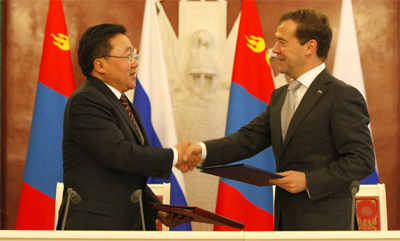
Mongolia and Russia Re-Invigorate Mutual Ties
Publication: Eurasia Daily Monitor Volume: 9 Issue: 207
By:

Since the Mongolian parliamentary elections of June 28, 2012, won by the pro-Western Democratic Party, there has been a re-emphasis on strengthening Mongolian-Russian political and military relations as part of the new government’s efforts to counter-balance China’s monopoly over Mongolia’s economy. On November 3, 2012, Russia and Mongolia celebrated in Moscow and Ulaanbaatar the 100th anniversary of the signing of their Agreement of Friendship, which is the basis of their bilateral relationship. This document, signed in Urga (now Ulaanbaatar) in 1912 by Mongolian religious and civil authorities and the famous Russian ambassador to Manchu China, Ivan Yakovlevich Korostovets, is embraced by the Mongolians as “recognition of the independence of the Mongolian state” (www.infomongolia.com, November 2). This interpretation—tacitly accepted by Russian authorities despite strong rejection by Beijing because of its implications regarding Chinese claims on Tibet—is another step in Mongolian President Tsakhiagiin Elbegdorj’s campaign to definitively assert the legitimacy of Mongolia’s claim to legal separation from China since the first decade of the 20th century.
The anniversary comes not five days after the Eighth Consultative Meeting of the foreign ministries of Russia, China and Mongolia in Moscow. Hosted by Russian Deputy Minister of Foreign Affairs, Igor V. Morgulov, the participants included Tumurkhuleg Tugsbilguun, Mongolia’s Director of the Department of Neighboring Countries in the Ministry of Foreign Affairs (MFA); A. B. Kulik, Head of First Asia Department in the Russian MFA; and Luo Zhaohui, Director of the Department of Asian Affairs in the Chinese foreign ministry. Topics covered trilateral cooperation in the mining sector and transit development among the three nations, as well as infrastructure, tourism, environmental and humanitarian concerns. (www.infomongolia.com, November 1). It is not clear if the discussions were influenced by the rumor that swept Mongolian media in early July that claimed Russian Foreign Minister Sergei Lavrov, while commenting upon the lifting of visa requirements for Mongolian citizens, had announced that Mongolia will rejoin the Russian Federation as an autonomous republic in May 2014. Even Mongolian financial investment blogs carried the comment. Mongolian parliamentary speaker Damdiin Demberel reportedly responded that Mongol and Russian blood was the same: “Old resentments are forgotten for a long time; we will be together again. And this is the right decision” (www.mad-mongolia.com/news/, July 1). To date there has been no definitive clarification of Lavrov’s exact statement.
Mongolia and Russia have acted to boost their bilateral political and economic ties this year. On October 19, Sergei M. Mironov, Chairman of the Council of Inter-Parliamentary Assembly of States in the upper house (Federation Council of Russia) and Head of the Russia-Mongolia inter-parliamentary group, received Mongolian Ambassador to Russia Doloonjin Idevkhten to review efforts to deepen relations between the State Duma and Mongolia’s parliament. Ambassador Idevkhten responded by emphasizing the importance Mongols place on Russian cooperation as indicated by the unwritten rule in the Mongolian parliament that its Vice-Speaker (currently MP Logiin Tsog) also chairs the Mongolia-Russia inter-parliamentary group (The Mongolia Messenger, October 26). Miranov had previously met with MP Demberel on several trips to Ulaanbaatar for discussions on problems along the border regions, the establishment of border economic free-trade zones, and the acceleration of bilateral cooperation on uranium exploration.
In addition, joint military relations have also not been neglected by the two sides. Russian-Mongolian military exercises called Selenga 2012 were conducted on September 21–30 near Kyakhta in Russia’s Republic of Buryatia, in southern Siberia. These joint military exercises, which were eliminated after the collapse of the Soviet Union, have been held yearly since 2008, in response to Mongolia’s growing military cooperation with the United States. In Selenge 2012, the Mongolians were represented by 250 motorized infantry and tank units, as well as an air-defense and a mortar battery. Three hundred soldiers from motorized infantry and tank units of the Russian Eastern Military District, as well as batteries of the Grad multiple-launch rocket system and Gvozdika (Carnation) self-propelled gun mounts also participated. (https://zeenews.india.com/news/, September 21). Mongolian blogs and Russian radio reported that Russian and Mongolian special task forces focused on joint counter-terrorism measures, blocking and destroying imaginary illegal armed groups trying to break through the Russian border into Mongolia, and that, for the first time, the joint forces included aircraft drills (mongoliaeconomy.blogspot.com/2012/09; ruvr.ru/2012_09_29/). This exercise followed upon the 12th annual Khaan Quest (KQ12) joint exercise, which brought together the Mongolian Armed Forces and US Army Pacific forces, including Alaskan National Guard units, in mid-August. KQ12 involved more than 1,000 troops, including approximately 300 US personnel and soldiers from South Korea, India, Canada, New Zealand, Australia, Japan, France, the UK and Germany. Russia, Kazakhstan and China sent observers.
Mongolia believes that it must propel its Russian relations beyond the political and military arena to more substantive economic ties. The appointment on October 19 of Mendsaikhany Enkhsaikhan, former Prime Minister of Mongolia and current chairman of the National Democratic Party (NDP), to the powerful position of executive director of the state-owned Mongolian Railway is an indication that Mongolia now will emphasize finding $250 million for its Ulaanbaatar Railway Mongolian-Russian Joint Stock Venture (UBTZ). Improved north-bound rail links are viewed as the key to moving Mongolian minerals to Russian, Japanese and Korean buyers, and thus diversifying trade partners. Mongolia’s swing back toward its northern neighbor is likely to be maintained for as long as domestic perceptions of Chinese economic domination persist.




